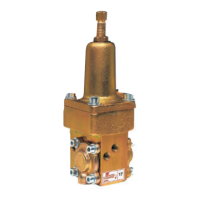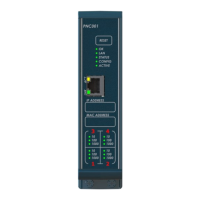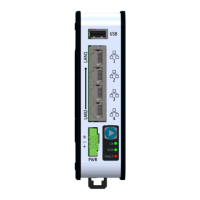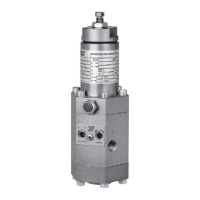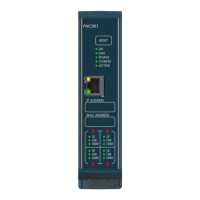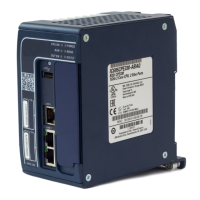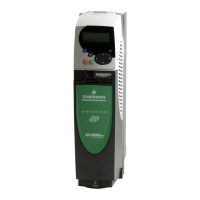Powerdrive F300 Getting Started Guide 87
Issue Number: 5
Safety
information
Product
information
Mechanical
installation
Electrical
installation
Getting started
Basic parameters
(Menu 0)
Running the
motor
Optimization
NV Media Card
Operation
Further
information
UL listing
information
Pr 00.007 {05.014} Open Loop Control Mode
There are several voltage modes available which fall into two categories, vector control and fixed boost.
Vector control
Vector control mode provides the motor with a linear voltage characteristic from 0 Hz to motor Rated Frequency
(00.047), and then a constant voltage above motor rated frequency. When the drive operates between motor
rated frequency/50 and motor rated frequency/4, full vector based stator resistance compensation is applied.
When the drive operates between motor rated frequency/4 and motor rated frequency/2 the stator resistance
compensation is gradually reduced to zero as the frequency increases. For the vector modes to operate correctly
the Rated Power Factor (00.043), Stator Resistance (05.017) and Voltage Offset At Zero Current (05.058) are all
required to be set up accurately. The drive can be made to measure these by performing an autotune (see
Pr 00.040 Autotune). The drive can also be made to measure the stator resistance and voltage offset
automatically every time the drive is enabled or the first time the drive is enabled after it is powered up, by
selecting one of the vector control voltage modes.
(0) Ur S = The stator resistance and the voltage offset are measured and the parameters for the selected
motor map are over-written each time the drive is made to run. This test can only be done with a stationary
motor where the flux has decayed to zero. Therefore this mode should only be used if the motor is
guaranteed to be stationary each time the drive is made to run. To prevent the test from being done before
the flux has decayed there is a period of 1 second after the drive has been in the ready state during which the
test is not done if the drive is made to run again. In this case, previously measured values are used. Ur S
mode ensures that the drive compensates for any change in motor parameters due to changes in
temperature. The new values of stator resistance and voltage offset are not automatically saved to the drive's
EEPROM.(4)
(4) Ur I = The stator resistance and voltage offset are measured when the drive is first made to run after each
power-up. This test can only be done with a stationary motor. Therefore this mode should only be used if the
motor is guaranteed to be stationary the first time the drive is made to run after each power-up. The new
values of stator resistance and voltage offset are not automatically saved to the drive's EEPROM.
(1) Ur = The stator resistance and voltage offset are not measured. The user can enter the motor and
cabling resistance into the Stator Resistance (05.017). However this will not include resistance effects within
the drive inverter. Therefore if this mode is to be used, it is best to use an autotune test initially to measure
the stator resistance and voltage offset.
(3) Ur_Auto = The stator resistance and voltage offset are measured once, the first time the drive is made to
run. After the test has been completed successfully the Open Loop Control Mode (00.007) is changed to Ur
mode. The Stator Resistance (05.017) and Voltage Offset At Zero Current (05.058)) parameters are written
to, and along with the Open Loop Control Mode (00.007), are saved in the drive's EEPROM. If the test fails,
the voltage mode will stay set to Ur Auto and the test will be repeated next time the drive is made to run.
Fixed boost
Neither the stator resistance nor the voltage offset are used in the control of the motor, instead a fixed
characteristic with low frequency voltage boost as defined by Pr 00.008, is used. Fixed boost mode should be
used when the drive is controlling multiple motors. There are two settings of fixed boost available:
(2) Fixed = This mode provides the motor with a linear voltage characteristic from 0 Hz to Rated Frequency
(00.047), and then a constant voltage above rated frequency.
(5) Square = This mode provides the motor with a square law voltage characteristic from 0 Hz to Rated
Frequency (00.0 47), and then a constant voltage above rated frequency. This mode is suitable for variable
torque applications like fans and pumps where the load is proportional to the square of the speed of the
motor shaft. This mode should not be used if a high starting torque is required.
Powerdrive F300 Getting Started Guide English Iss2.book Page 87 Tuesday, July 28, 2015 3:23 PM
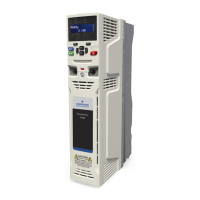
